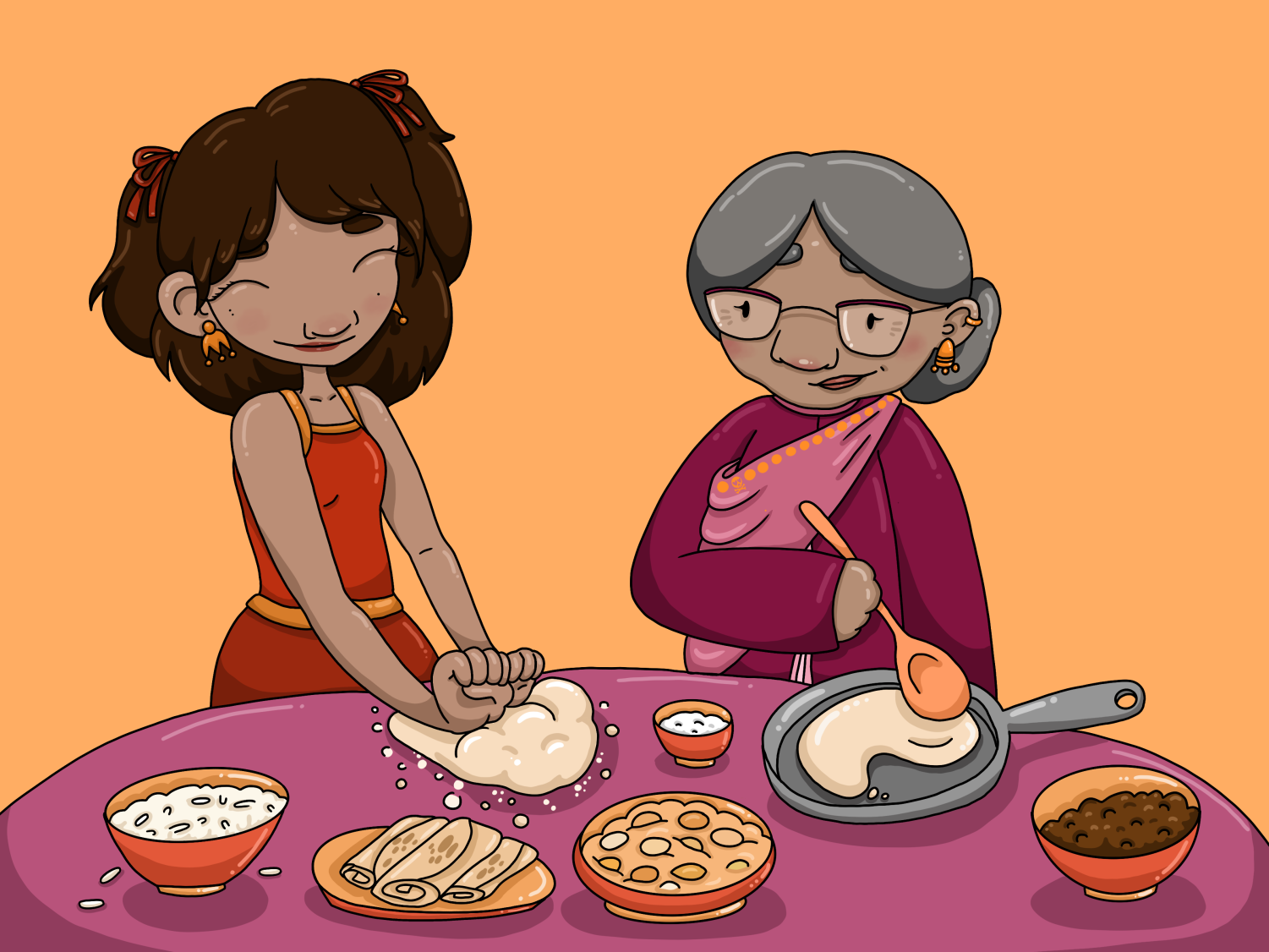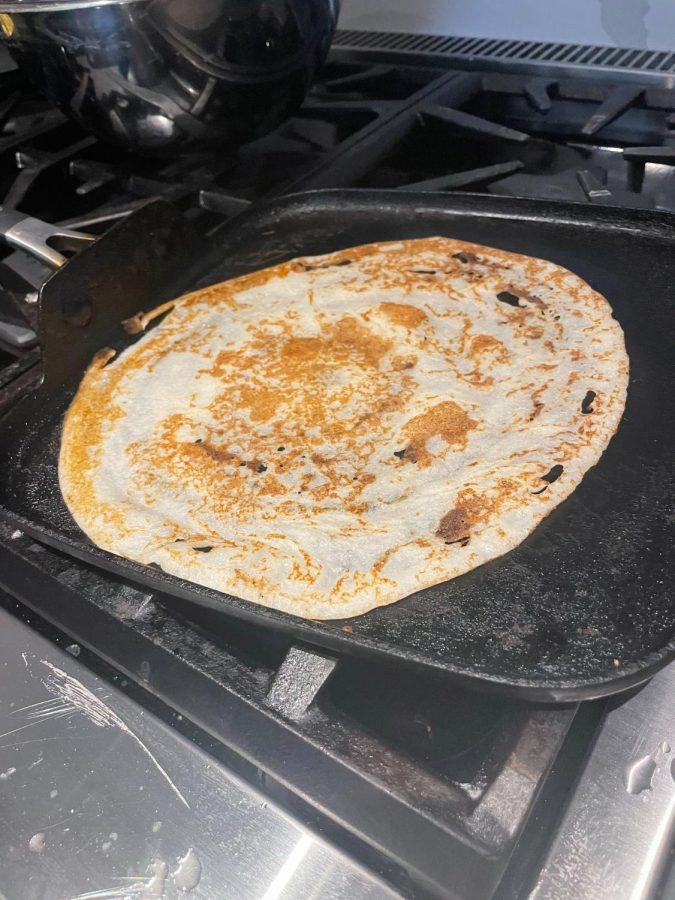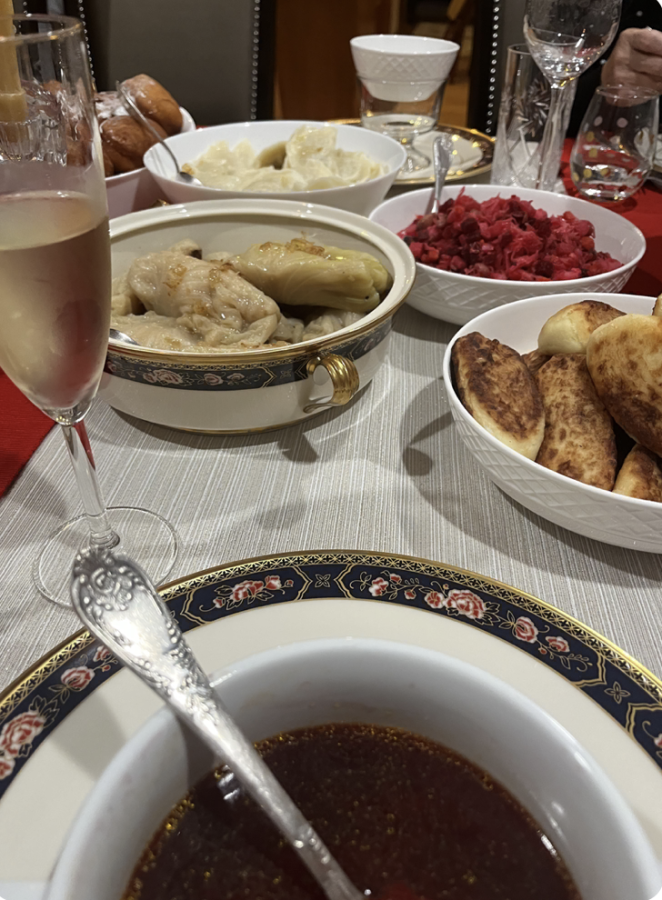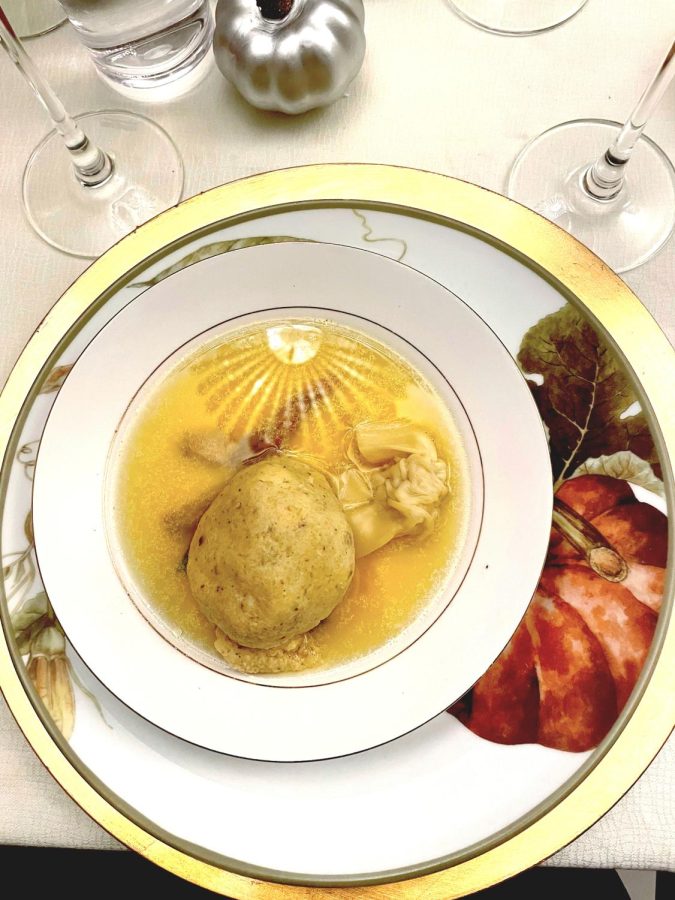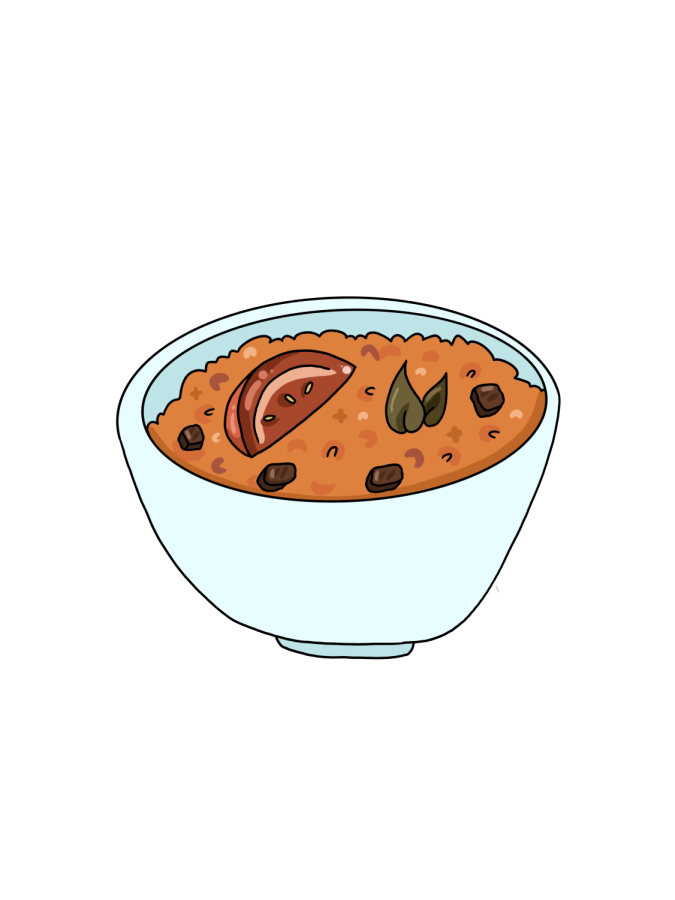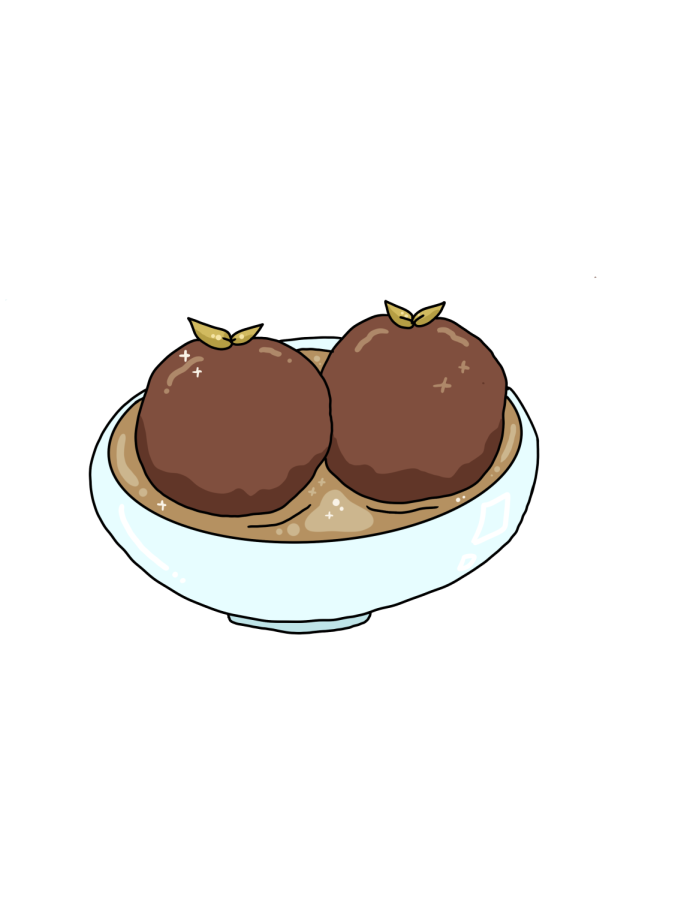The flavors of family
April 5, 2023
What’s the recipe for home?
1. Start with a cup of comfort
2. Throw in some traditional techniques
3. Finally, let it simmer for a generation
These ingredients aren’t essential for a meaningful meal, but for five U-High students of different cultures and backgrounds, food is inextricably connected to their personal and cultural identity and central in forging lasting bonds among generations of family members.
Anokha Nathan fries dosa, South Indian staple, with grandmother
Anokha Nathan
DOSA DISHES. Anokha Nathan looks forward to her grandmother’s dosas made using recipes that have been passed down for generations.
Homey. It’s a feeling that comes to mind for senior Anokha Nathan as she stands beside her grandmother, measuring out a cup of batter. As she pours the gooey mixture into a hot pan with a sizzle, the bubbly circles fuse into crispiness, releasing an aroma which wafts throughout her kitchen, the smell of comfort.
Anokha’s making dosa, a traditional South Indian crêpe-like staple often dipped in curry, filled with potatoes or eaten as a side dish. To Anokha, making and eating her grandmother’s original dosa recipe is central to her South Indian identity and a sense of togetherness shared among herself and her family.
Since Anokha’s maternal grandparents live with her, food is an essential part of the household, and family meals are often cooked by her grandmother. On weekends, Anokha wakes up to the smell of her grandma frying dosas and cooking other Indian foods from scratch.
“That is what my grandma makes for breakfast a lot on the weekends,” she said. “It’s probably one of my favorite foods in the whole world –— that’s what I’m always looking forward to.”
Dosa is made with fermented rice batter. When heated at high temperatures, the batter fries into a thin but chewy pancake.
“We always have the batter, like, on hand — my grandma makes it in bulk,” Anokha said. “So if anyone like needs it — and sometimes it’s not even breakfast — sometimes I’ll wake up really late one day, and I’ll be like, ‘That’s all I want right now, and Grandma can make it super quick.’”
Anohka’s family uses recipes passed down through generations, and that originality gives their food authenticity and life. Anokha herself learned to make dosa under the careful eye of her grandmother.
“My mom and my grandma cook huge Indian feasts and things you could really only get in India, like stuff they’ve learned from experience, not from lessons or online. It’s all recipes that have been passed down,” she said. “I feel very fortunate to have them in my house every single day.”
For Anokha, making dosa is more than just a generational technique, it’s a personal experience that reminds her of home and allows her to connect with those she cherishes most. No matter what stereotypes are attributed to her Indian heritage, Anokha is proud of the food and culture her family makes.
“For me, the smell of Indian food is very comforting and I just know that smell — it smells like my house,” she said. “It’s interesting because even if you go to Indian restaurants and you smell the same food, it doesn’t smell like my grandma’s, and it doesn’t smell like my home.”
Sophia Shimanska overcomes distance with Ukrainian perogies
Sophia Shimanska
PLATING PEROGIES. The Ukranian dish is often seen on the holiday table of Sophia Shimanska.
Christmas Eve, Easter and other holiday dinner tables are often filled with different foods, both traditional and more specific to a family’s heritage or tastes. For sophomore Sophia Shimanska, holiday dinner tables are filled with traditional Ukrainian dishes and treats — from Easter bread to sweet or savory perogies — that have been carried through her family for generations.
Cooking traditional Ukrainian cuisine is something Sophia looks forward to because it allows her to connect to Ukrainian culture thousands of miles away.
One of the most notable dishes Sophia makes are perogies, a type of dumpling with a savory or sweet filling.
“There’s so many steps, like making the dough, then also making whatever the filling is — it could be potato, it could be cherry,” Sophia said. “We also did blueberry and strawberry once, and the strawberry ones were really good.”
The process of making perogies is somewhat simple: make the flour dough, prepare the filling and put the dish together.
According to Sophia, all you need to do is add flour, eggs, water, salt and seasoning. Then make the potato filling with potatoes, farmer’s cheese and cooked onions.
These dishes ignite special memories for Sophia, from traveling back to Ukraine to visit her grandmother to fun holiday traditions that have been in her family for generations.
“It makes me remember and connect to the people that are currently in Ukraine,” Sophia said. “I remember when I went to Ukraine — I think in like 2019, maybe 2018 — but when I came home my grandma made me pierogies right when we came into the house and they were, like, nice and fresh from the night before.”
For Sophia, food isn’t just a way to connect to her immediate family but a way to connect her to her Ukrainian heritage and a country that she hasn’t been able to visit since 2019 due to COVID-19 and the war with Russia. These traditional dishes have been around for centuries, so being able to cook the same dishes helps Sophia connect to her culture.
“Using the same recipes that my ancestors have used, who lived in the Ukraine for their entire lives, I feel like that kind of helps me connect to my culture. Because you don’t really see a lot of Ukrainian restaurants,” Sophia said.
Cooking and baking traditional dishes lets Sophia connect to her culture and family in Ukraine. From helping her mom prep in the kitchen to enjoying the freshly made perogies that her grandmother made in Ukraine, cooking is something in Sophia’s life that connects her to family thousands of miles away.
Amelie Liu finds intersectional identity through matzo ball soup
Amelie Liu
MATZO MOMENTS. Amelie Liu’s family comes together over matzo ball-wonton soup at holidays.
The table is set. She gazes over the typical Thanksgiving dinner spread of turkey, mashed potatoes, stuffing and gravy. Yet at the end of the table sits a holiday dish most memorable to senior Amelie Liu: her family’s matzo ball-wonton soup, which combines both her Chinese and Jewish backgrounds into a single flavorful dish. For Amelie, this is the centerpiece.
One essential component of the dish are matzo balls, which are made from ground matzo, an unleavened flatbread. The meal from the bread is then rounded into aerated spheres, which Amelie and her grandmother place in a rich chicken-and-vegetable broth.
Amelie also prepares wontons, made from a sticky dough that cements itself to her hands. After kneading the dough, she folds them into delicate pouches ready to be steamed. Careful not to burn her tongue before taking a bite, matzo ball-wonton soup delivers a taste that makes Amelie smile. The comforting taste reminds her of the valuable time spent with family and the pride she has discovered in her identity.
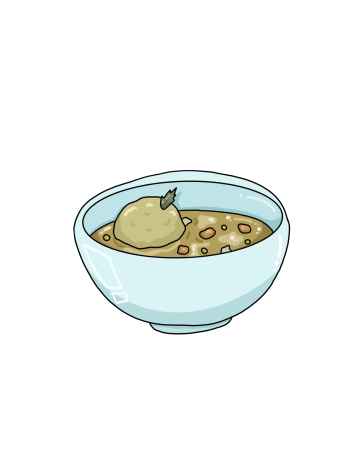
Amelie has eaten dumplings with her family on Rosh Hashanah and latkes for Chinese New Year, which she prepares with her grandmothers. Blending the cuisines of her background is an important staple for Amelie and her family’s traditions, which they share with others.
Amelie believes incorporating matzo ball-wonton soup into her family’s Thanksgiving traditions is a central part of her family’s identity and a reminder of the time they have to spend with one another.
“Having the matzo ball-wonton soup at the end of the table, and having everyone go around, and my mom making everyone take a serving of it was really special,” she said, “just as an homage to my identity and honoring that, and my siblings at this dinner table with my whole family.”
Cooking provides Amelie a way to bond with family members, but it has also been important in helping her find pride in the intersectionality of her family’s heritage
“I think that cooking has been really profound in my journey in terms of discovering my identity,” she said.
During the holidays, Amelie’s extended family travels from across the country. Even so, the unique traditions that have come to establish what Thanksgiving means to Amelie are experienced and shared with all who share their dinner table.
“We have a lot of UChicago students or Ph.D. students who are international students who don’t have a place to go for Thanksgiving,” Amelie said about her family’s connection to the University of Chicago, “so it’s a blend of many different people.”
Amira Williams sets her family table with jollof rice, fragrant West African blend of stew, spices
Family members huddle around the heart of the home, the kitchen. Vibrant conversations fill the room as some get to work. A large pot sits in the center of the kitchen, a vibrant orange jollof rice inside. The intense, zesty smell of the bouquet of peppers, spices and vegetables fills the air and permeates every room of the house.
Ever since sophomore Amira Williams could remember, her grandmother’s jollof rice has been on the table at any important celebrations with her family. Jollof rice is a rice dish that originated in West Africa and quickly became the region’s most popular dish with multiple variations depending on the country, some being served alongside meat, fish or plantains.
“Jollof is a dish that my family makes for almost every birthday, or after prayers, or just special occasions,” Amira said. “Prayers are super long, like they can go until really late at night, so it is really nice to come home and just have some really good food. And for birthdays, you just have to have it.”
She also expressed a strong sense of family connection from the process of making the rice.
“Usually my grandma makes it and my siblings and I watch her in the kitchen, and it is pretty cool to see the dish come together, Amira said. “But when I do help, I get the rice and help prepare it, and in the end you get to have a really nice meal with your family.”
The recipe is a flavorful and fragrant blend of different vegetables and spices that gives the rice its iconic orange color.
“So first you have to make the stew. So that’s with tomatoes, bell peppers, habaneros, scotch bonnet, bay leaf, and a bunch of spices, and you fry it with a bit of oil. The smell of the spices is so good,” Amira said. “Usually you would cook it on the stove, but my grandma always puts it in the oven, and it always turns out amazing.”
Amira said the type of rice used in this dish is crucial to it coming out perfect.
“You have to use long-grain rice,” she said. “Not basmati rice or jasmine rice, long-grain rice ensures that the jollof comes out nice and fluffy.”
For Amira, cooking jollof rice is far much more than simply the process of cooking.
She said, “I feel a sense of pride and excitement when I cook with my grandma because it’s just so good.”
Tara Sawhney experiences meaningful moments by cooking gulab jamun, North Indian delicacy
Sometimes, a food is so delicious or regularly eaten that it becomes more than just a food — it’s a comforting tradition that brings everyone who eats it together closer. For junior Tara Sawhney, the doughnut-like Northern Indian dessert gulab jamun is just that food.
Making gulab jamun from scratch is a laborious process. Its main ingredient is milk solids, which are derived from constantly stirring milk over a low flame, sometimes for hours, until almost all of the water has evaporated. These milk solids are kneaded along with flour and ghee (clarified butter) until everything incorporates stiff, smooth dough. The dough is then formed into small balls about the size of a doughnut hole, which are quickly deep fried in butter. The final product is drained of fat, and immediately put into warm sugar syrup to soak for a few hours.
“Typically my grandmother will make it, Tara said, “and we’ll have it with my parents and my brother. It’s pretty involved — boiling condensed milk, baking it, so on and so on. It takes a while, and is a bit of a process but definitely worth it, though.”
For Tara, preparing and eating gulab jamun is a special part of the multi-day festival of Diwali, which she and her close family celebrate every year.
“My family always celebrates Diwali,” Tara Sawhney said. “It’s usually a couple days of celebration, and every year we make sure to have gulab jamun. It’s always fun to relax and sit down with family after dinner and have some more food.”
To Tara, gulab jamun is also a reminder of family she can’t always eat with. Every so often, Tara visits her extended family in northern India, sometimes to celebrate Diwali. There, the holiday is a much longer, and much more involved, tradition.
“Diwali there is pretty different. It’s the entire city celebrating,” Tara said. “All of the parks are very crowded and very loud. I was there with my parents and brother of course, but we are with my other grandparents, and all my aunts and cousins. I remember in the evening, we had just lit fireworks, and then we just sat down somewhere and had gulab jamun. It was really nice.”
Tara doesn’t go to India every year to celebrate Diwali. However, no matter where she is or who she is with, eating gulab jamun allows her to slow down and take a moment to appreciate the flavor of family.
